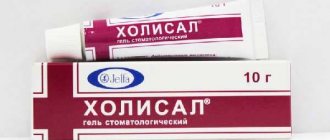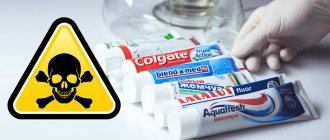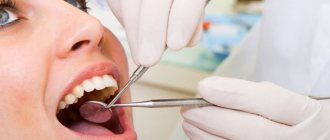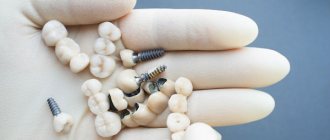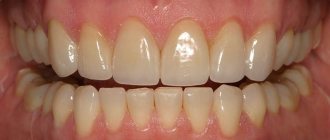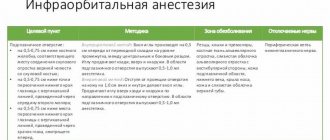carpule anesthesia in dentistry: what is it and how is it carried out?
659
The fact that modern methods of dental treatment are carried out almost painlessly is an undoubted achievement in dentistry and the use of effective drugs as an anesthetic.
Many patients, especially older people, are sincerely surprised by the options for freezing the working area, the bizarre shapes of syringes and disposable ampoules.
This article will discuss one of the innovative methods of performing pain relief procedures - carpule anesthesia.
General overview
The name of the technique is due to the design of the syringe, the contents of which sharply reduce the sensitivity threshold of the nerve tissues of the tooth.
The capsule in which the drug is placed is called carpula. Despite the specific packaging of the drug, the manipulation technology itself is standard.
A carpule injection is a reusable syringe. This device is made of a medical metal alloy, and consists of a frame, a piston part and a needle. In this case, the piston cannot be completely removed from the housing, on the side of which there is a gap to accommodate the capsule.
It is a special ampoule containing an anesthetic composition. The capsule is hermetically sealed, has a rubber plug at one end, and a metal valve at the other.
The device works on the following principle - after the cartridge with the necessary product is placed in the gap of the syringe, a needle is screwed into it and an injection is made.
In this case, the plug should be on the side opposite to the needle. When you press the piston, the medicine is injected into the organ cavity and reaches the target.
Advantages
According to practicing dentists, this type of anesthesia has the following advantages over analog painkillers:
- adherence to the dosage as accurately as possible. One carpool unit holds 1.7 ml contents;
- 100% sterility - each injection is performed with a disposable needle, and the contents of the capsule are pumped in strict accordance with antiseptic requirements. Compliance with sterility standards is especially important for those patients whose immune system is weakened by serious diseases, such as diabetes;
- good tolerance - the needle that comes with the device is so thin that inserting it into soft tissues causes virtually no pain. In addition, it simplifies the administration of the drug where the mucosa is close to the periosteal zone;
- comfortable working conditions for the dentist - the syringe is conveniently located in the doctor’s hand and, unlike standard syringes, is easily directed in different directions due to its design features. The needle is so flexible and durable that it can be bent without fear of it breaking and injuring the patient;
- impossibility of administering the wrong drug - the packaging contains a marking with the name and dosage of the composition located inside the capsule.
Flaws
As for the negative aspects of carpule anesthesia, practically none have been identified.
A number of patients note the high cost of the drug, which makes it limited to the category of citizens with low material income.
However, this is a controversial drawback, since the complexity of manufacturing the product and high efficiency are associated with additional manufacturing costs. A quality product cannot be cheap.
Another disadvantage is the inability to modify the composition. A vasoconstrictor cannot be added to it, but in some clinical cases this is necessary.
Injector contents
The use of the drug requires the dentist to know the composition of the anesthetic. This information is contained on the packaging; there is a detailed breakdown of the percentage of all its components.
Injector includes:
- An anesthetic is a substance that reduces the pain sensitivity threshold in the injection area to a minimum. These compounds are classified under the category of amides and their derivatives. These are mainly Lidocaine, Prilocaine, Articaine;
- vasoconstrictor – activates vasoconstrictor processes, which prolongs the relief of nerve endings and increases the effect of the drug. In addition, the substance prevents premature leaching of the drug from the working area. It has a serious limitation for use - the drug is prescribed with extreme caution to people with pathologies of the cardiovascular system, diabetes mellitus at any stage of the disease, and elderly patients. Vasoconstrictors include adrenaline, mesaton;
- antioxidants are mainly sodium sulfites or bisulfites. Their main function is to protect the vasoconstrictor from destructive processes that occur under the negative influence of an oxygen environment. They can provoke individual intolerance, including acute allergic reactions, since they contain sulfur fragments. Contraindicated for diseases affecting the lungs and bronchi;
- preservatives – ensure the safety of the composition until it is opened;
- EDTA – metal binder;
- parabens are fragments that ensure absolute sterility of the capsule contents. This is especially important when transporting to regions with hot climates.
Thanks to this balanced composition, the anesthetic is reliably protected from the penetration of pathogenic microorganisms.
The main requirement related to the specific composition of the anesthetic is to make sure before using the medicine that the patient is not allergic to its derivatives.
Neglect of this rule is fraught with anaphylactic shock, which can cause irreparable harm to human health.
The video provides a description of an innovative single-use carpule syringe.
Storage rules and periods
Any medicine needs proper storage. Capsules must be kept in a dark place. The optimal storage temperature is 23-25 degrees.
Failure to comply with basic conditions will shorten the shelf life of the composition, and improper transportation may compromise the structural integrity of the package.
Such drugs should not be used under any circumstances. Injectors should be stored in places inaccessible to children and pets.
Signs of loss of drug properties
You can understand that the medicinal effect of the drug has been neutralized and it has lost its main characteristics by a number of signs:
- the integrity of the packaging is compromised - most often this is due to careless transportation;
- An uncharacteristic sediment has appeared in the liquid or the shade of the composition has changed - this happens when the temperature regime is violated, causing overheating. The vasoconstrictor disintegrates and the agent changes its structural content;
- the appearance of gas bubbles larger than 0.2 cm. This is a consequence of freezing;
- the appearance of rust fragments on the outside of the ampoule.
Requirements for drugs
The main requirements put forward by specialists for drugs used as pain relief:
- predictability of the effect - the doctor must be sure that the result will be profound and the duration of its action will be enough to carry out treatment;
- safety - the medicine should not have allergic manifestations, not contain toxins, and have a minimum of side effects.
Popular means
The most popular option for carpule anesthesia is the products of French manufacturers, which are effective and affordable:
- Ultracaine is the most popular concentration for dental pain relief. The effect occurs after a couple of minutes and lasts for at least an hour;
- Ubistezin - the duration of pain relief does not exceed half an hour, this time is sufficient in most clinical cases. Indications for use: children, pregnant women;
- Scandonest – has a high concentration of adrenaline. Side effect is a long-term vasoconstrictor result. Prevents bleeding;
- Septanest - has a mild effect. The sensitivity threshold remains extremely low for 15-20 minutes. Indicated for people prone to allergies, with severe pathologies and serious chronic diseases, when the use of stronger drugs is not recommended.
Reasons for the lack of pain relief
In some cases, the effect of the product may be minimal or absent altogether, that is, tissue sensitivity remains almost at the same level.
There are reasons for this. If we exclude damage to the packaging and a violation of the properties of the composition, the lack of pain relief is explained by the following factors:
- fear of the upcoming procedure - fear blocks other reflexes, and anesthesia does not occur;
- production of adrenaline - it is intensely produced in moments of panic and enters the nerve cells, neutralizing the effect of the drug.
To exclude such manifestations, experts recommend that patients prone to panic fear of the dentist take a sedative half an hour before the procedure.
Chronic alcohol dependence, as well as the body’s addiction to the drug, can have an inhibitory effect.
Reviews
Carpule anesthesia is used almost everywhere in domestic clinics.
Its main purpose is to eliminate the fear of treatment and make it as comfortable as possible.
Source: https://www.vash-dentist.ru/lechenie/zubyi/karpulnaya-anesteziya-v-stomatologii-chto-eto-takoe.html
Carpule anesthesia in dentistry: advantages and disadvantages
- What is carpule anesthesia?
- Advantages of carpule anesthesia
- Disadvantages of carpule anesthesia
- Requirements applicable to local anesthetics
- What anesthetics are most often used
- Which anesthetic is better
The most important condition for modern treatment is the painlessness of all therapeutic and diagnostic procedures. Dentists are still trying to achieve better pain relief in order to smooth out the factors that traumatize the patient’s psyche and cause him to fear dentists.
Carpule anesthesia is pain relief using a special syringe. It is used for comfortable and safe anesthesia.
Carpule syringe
A carpule syringe is a reusable metal device equipped with a piston, needle and body.
The piston in this case cannot be completely removed by moving backwards, like a disposable syringe; in addition, in the side of the syringe body there is a special recess for the carpule - a special ampoule containing an anesthetic, hermetically sealed and equipped with a rubber stopper at one end and a metal cap at the other end.
Experts include anesthetics based on Articaine among the most modern painkillers.
According to experts, the principle of operation of a carpule syringe is as follows: the required carpule is placed in the syringe, then a disposable needle is attached to it, after which the device is ready for use.
The cartridge must be inserted in such a way that the cap is on the side of the needle, since it must be pierced by its reverse end, and the plug must be located on the piston side.
Pushing the plug with a piston ensures that the anesthetic moves along the needle into the depths of the tissue.
At the moment, in modern dental institutions, specialists use carpule syringes, which are convenient and technically sophisticated.
Advantages of carpule anesthesia
According to experts, carpule anesthesia has the following advantages:
- Exact dosage of the amount of anesthetic. Each carpule contains 1.7 milliliters of anesthetic, which makes it easier to control the dose of anesthesia
- Sterility. A disposable needle is used for each individual patient, and the solution inside the capsule is sealed in compliance with aseptic standards. This is very important, especially when treating patients with low levels of immunity, for example, with immunodeficiencies or diabetes mellitus
Anesthesia
- Easy to tolerate for the patient. The needle of a carpule syringe is thinner than a disposable syringe, so its insertion into the tissue is practically not felt. Among other things, it can facilitate technical anesthesia for a specialist and subjective sensations for the patient during infiltration anesthesia from the lingual and palatal side of the jaw, where the mucous membrane has a very tight adhesion to the periosteum
- Convenience for the specialist. A carpule syringe is much easier to hold in the hand and point to the sides than a disposable syringe. This is possible thanks to its thoughtful design. The needle of such a syringe has great flexibility, which allows, if necessary, to bend it with almost no restrictions without fear of breaking off
- Completely eliminating the possibility of injecting a foreign substance or other anesthetic. Medicine knows of cases when, during the process of pain relief, a specialist administered the wrong anesthetic, and in some situations, a completely different substance was administered to the patient, for example, an antiseptic or alcohol. Carpule anesthesia eliminates the possibility of such an outcome, since each carpule indicates the name of the drug for pain relief, its concentration and quantity
Disadvantages of carpule anesthesia
Despite the existing minor drawbacks, carpule anesthesia has taken a strong place among modern options for pain relief. These disadvantages include:
- Price. This is mainly due to the complexity of the carpule syringe design. In addition, high-quality carpule syringes are more expensive than cheaper options
- Inability to modify the anesthetic. A specialist who uses carpule anesthesia does not have the opportunity to add a vasoconstrictor if necessary, because it is impossible to open the carpule before direct use
Requirements for local anesthetics
Classic requirements for local anesthetics:
- Minimal allergenicity and toxicity
- No damaging effects on nerves and tissues
- As low as possible the likelihood of side effects and complications
- Rapid absorption by the body
- However, in addition to the classical requirements for anesthetics, additional requirements must also be applied that will improve the quality of treatment
Additional requirements for local anesthetics:
- Deep and complete anesthesia of the pulp, hard tissues, oral mucosa and periapical tissues
- Quite fast onset of pain relief (no more than five minutes)
- Long-lasting effect - anesthesia should ensure complete painlessness throughout the entire treatment, including in the last stages of the operation. Thus, the duration of action of the anesthetic, especially for complex operations, should be about an hour
- Complete and rapid cessation of anesthesia after the end of the procedure, that is, after 2.5 - 2 hours
- Preservation of pharmacological properties and chemical stability during storage, that is, for 2-3 years
Carpule anesthesia
What anesthetics are most often used
Experts include anesthetics based on Articaine, the active substance used in anesthetics called Septanest, Ubistezin Ultracaine and many others, among the most modern painkillers. Anesthetics of the articaine series are distinguished by an effect that is 1.5-2 times more effective than lidocaine and 5-6 times more effective than novocaine.
An important advantage of articaine anesthetics over other painkillers is their effectiveness in anesthetizing the area of inflammation. For example, with purulent inflammation, Novocaine has practically no effect, and the activity of Lidocaine is greatly reduced.
At the moment, in modern dental institutions, specialists use carpule syringes, which are convenient and technically sophisticated.
Many anesthetics, in addition to the basic anesthetic component, for example, articaine, also contain vasoconstrictors such as epinephrine and adrenaline. Such substances, due to the constriction of blood vessels at the injection site, reduce the washout of the anesthetic, which increases the strength and duration of anesthesia.
Ultracaine
Experts identify the following commonly used modern anesthetics:
- Ultracaine. This product is produced by a company from France called Sanofi Aventis in 3 variants, differing in the presence or absence of epinephrine and its concentration. Ultracain D does not contain epinephrine and preservatives, Ultracain DS has an epinephrine concentration of 1:200,000, Ultracain DS forte – 1:100,000
- Ubistezin. This product is produced by a company from Germany under the name ZM in 2 concentrations of epinephrine. Ubistezin has an epinephrine concentration of 1:200,000, Ubistezin forte – 1:100,000. The composition does not differ from the composition of Ultracaine
- Septanest. This product has been used in dentistry for many years and is available in 2 versions with adrenaline concentrations of 1:200,000 and 1:100,000. Septanest, unlike Ultracaine and Ubistezin, contains preservatives that can cause allergies
- Scandonest. This product is produced by a company from France called Septodont; Scandonest is based on Mepivacaine 3%. The anesthetic does not contain vasoconstrictor ingredients or preservatives. It is used in dentistry only for patients at risk, for whom anesthetics with epinephrine and adrenaline are not permitted, and for persons with bronchial asthma. Experts call the anesthetic Mepivastezin 3%, produced by the German company ZM, an analogue of the drug.
Which anesthetic is better
Many argue that almost all modern anesthetics act the same and reliably “freeze” the jaw.
Regular Ultracaine is suitable for almost everyone, but some prefer Ubistezin, although, in essence, they are no different in composition.
The main thing that both patients and doctors advise is to undergo allergy tests before administering the anesthetic in order to avoid unpleasant incidents.
It is also worth noting that pain relief depends not only on the anesthetic - anesthesia technique plays an important role. So if you felt pain during treatment, then the problem is most likely not in the anesthetic, but in how the doctor administered the anesthesia.
Useful article?
Save so you don't lose!
Disclaimer: This material is not intended to provide diagnosis, treatment, or medical advice. The information is provided for informational purposes only. Please consult your physician regarding any medical or health-related diagnoses or treatments. This information should not be considered a substitute for consultation with a physician.
Source: https://stom.32top.ru/stat/339/
Modern aspects of intraosseous dental anesthesia
G. M. Fleisher , consultant physician, State Healthcare Institution "Regional Dental Clinic - Dental Center" (Lipetsk), two-time world record holder of the Guinness Book of Records
Toothache is one of the most severe pains and occurs when a tooth is damaged by a pathological process. Dental treatment eliminates pain, but is often a very painful procedure. The main factor influencing the quality of therapeutic actions (operations) in dentistry is effective anesthesia.
The success of modern dentistry is largely facilitated by the development and introduction into practice of new tools and methods that make it possible to painlessly carry out long-term and traumatic interventions in the oral cavity. In the early nineties of the last century, the market for dental services, steadily expanding in form and content, began to be actively saturated with modern equipment - dental units, instruments, filling and endodontic materials. Advanced technologies, highly effective in functional and aesthetic terms, but at the same time labor-intensive and difficult to implement, have begun to be actively introduced into everyday practice. Their implementation was possible only against the background of high-quality local anesthesia, which provided reliable anesthesia for the entire range of dental interventions performed. Highly effective and safe pain relief has become an absolutely necessary condition for providing quality dental treatment. The effectiveness of anesthesia largely depends on the choice of anesthetic, anesthesia technique, injection instruments and route of administration of the anesthetic. The most widely used are application, infiltration and conduction methods of local anesthesia. An alternative to infiltration and conduction anesthesia may be intraosseous dental anesthesia (spongy), in which the anesthetic is injected directly into the spongy substance of the jaw or alveolar process between the roots of the teeth. Intraosseous dental anesthesia in dentistry was first performed in 1891 by the Norwegian physician Otte, who performed an intraosseous dental injection of a cocaine solution through a hole drilled with a bur in the cortical plate of the lower jaw. English and American researchers give primacy to their compatriots A. S. Parrot (1910) and G. N. Hein (1906). French researchers believe that the discoverer of intraosseous dental anesthesia in 1907 was their compatriot, Dr. Nogui. The technique of intraosseous dental anesthesia, described by Nogui as "transcortical anesthesia", was identical to the technique previously proposed by Otte. The effectiveness of anesthesia largely depends on the choice of anesthetic, anesthesia technique, injection instruments and routes of administration of the anesthetic. The term “transcortical anesthesia” is used by French authors, corresponds to the Russian term “intraosseous anesthesia” and emphasizes that during anesthesia the needle penetrates the cortical plate. Several methods have been proposed to perforate the cortical plate in order to inject an anesthetic into the cancellous bone tissue, which are presented in Fig. 1.
Technique for performing intraosseous dental anesthesia At the site of the bone puncture, infiltration anesthesia is performed, the mucous membrane is dissected, after which, at low speeds, a drill with a spherical bur trephines the cortical plate of the bone immediately above the interdental papilla (on the upper jaw) or below it (on the lower jaw). The site of perforation is located in a vertical plane, dividing the interdental papilla in half and 2 mm below the gingival margin of adjacent teeth. The bur is buried into the spongy bone of the interdental septum at an angle of 45° to the longitudinal axis of the tooth to a depth of 2 mm. The method of intraosseous dental anesthesia was not widespread due to the difficulties associated with the imperfection of needles and injectors. Through the formed channel, the needle is inserted into the spongy bone in the area of the interdental septum, with a certain force it is advanced 1-2 mm in depth (with sclerotic changes in bone tissue, this is difficult to do, but quite easy to do at a young age) and slowly inject from 0.5 ml (when using a strong anesthetic) to 1.5 ml of a weak anesthetic solution. Immediately strong pain relief occurs in the adjacent teeth. It should be noted that the diameter of the bur must match the diameter of the needle, otherwise the anesthetic solution will leak into the oral cavity. A detailed study of the mechanism of intraosseous dental anesthesia was carried out by A. Zh. Petrikas (1974, 1983, 1997), who, based on clinical, histological and radiological studies, formed an idea of the mechanism of action of intraosseous dental anesthesia. One of the ways the local anesthetic solution spreads is through its diffusion through the bone marrow spaces of the interdental septum and periapical region. The second way is the penetration of the solution into the vascular bed through the same spaces.
Rice. 1. Methods for perforating the cortical plate to inject an anesthetic into cancellous bone tissue
The method of intraosseous dental anesthesia was not widespread due to difficulties associated with imperfect needles and injectors. The emergence of new systems and computer injectors has returned interest in intraosseous methods of pain relief. Since 2006, dental practice has been using the Quick Sleeper automated injector and asymmetrically sharpened needles designed for conduction, infiltration and intraosseous anesthesia methods. Special needles were also developed for this injector, which have an offset center and a cutting side surface, which allows it to easily penetrate soft tissue and also perforate the cortical plate. Using the Quick Sleeper computer syringe, the technique of intraosseous dental anesthesia in dentistry has been significantly simplified. The use of intraosseous dental methods of pain relief using computer injectors requires clarification of the choice of local anesthetic, its quantity, distribution in tissues, time of onset and duration of anesthesia. The electronic Quick Sleeper system (Dental Hi Tec, France) provides ease of intraosseous dental anesthesia, thereby greatly facilitating everyday work. The exclusive PAR (Permanent Analysis of Resistance) system ensures uniform delivery of anesthetic regardless of tissue density and eliminates the risk of carpule breakage. Thanks to intraosseous dental anesthesia, the most complex clinical case becomes extremely simple. System composition: base unit, foot pedal for supplying anesthetic and aspiration sample, injector in the form of a pen with a cartridge for a standard anesthetic cartridge with a disposable needle. Cortical penetration, one-step anesthesia procedure. Electronic control of perforation and injection parameters, which prevents painful injection. The injector is shaped like a pen, so there is no need for force or pressure during injection of the anesthetic. Unlike other devices, there is no need for special consumables or replacement of various parts that increase the cost of operating the equipment. With the advent of this technology, intraosseous dental anesthesia changed its name to transcortical. The transcortical anesthesia technique is based on penetration through the cortical plate and injection of an anesthetic in close proximity to the tooth in need of treatment. The procedure is simple and does not take time, since treatment can begin immediately after the injection. The Quick Sleeper system offers two programmed anesthetic delivery rates. This ensures that the speed is appropriate for each clinical case. An additional “low” mode is used to anesthetize particularly sensitive areas, such as the frenulum of the tongue, or when working with children. Injections are carried out under constant control, are easy to perform, do not cause pain or damage tissue, and allow the doctor to focus only on the injection point.
Characteristics of anesthesia with the Quick Sleeper system:
- Instant action.
- Use of vasoconstrictors (up to 1:80,000 adrenaline) without the risk of necrosis.
- Highly effective for lower molars and teeth with pulpitis.
- There is no need for a palatal or lingual injection even for tooth extraction.
- There is no numbness of soft tissues.
- Minimum amount of subjective sensations. There is no paresthesia of the lips or tongue. There is a feeling of numbness in the tooth (“the tooth has become wooden”).
- Anesthesia from 2 to 8 teeth.
- High efficiency due to maximum coincidence of the injection target and the object of intervention, minimizing the resorptive effect.
- Low duration of effect, corresponding to the dose of anesthetic (15-20 minutes), and the ability to control its duration.
The transcortical anesthesia technique is based on penetration through the cortical plate and the introduction of an anesthetic in close proximity to the tooth. In publication [3], the author, using the iCATvision program, studied the depth of needle immersion during intraosseous dental anesthesia in various areas of the upper and lower jaws, and determined the optimal insertion depth for each area. In publication [8], the authors studied conduction and intraosseous, dental methods of anesthesia using articaine-containing anesthetics. Intraosseous dental anesthesia is characterized by a faster rate of onset of pain relief (30-60 seconds) compared to conduction anesthesia (2-5 minutes), which makes it possible to begin treatment immediately after the injection. The introduction of 1.7-2.5 ml of Ultracain DS anesthetic during regional anesthesia provides pain relief for 40-60 minutes. Intraosseous injection of 0.2-0.4 ml Ultracain DS has an analgesic effect for 25-40 minutes. Direct evidence of vascular administration of the anesthetic is that in almost all cases of aspiration, blood was detected in the syringe body either in the form of noticeable traces or, more often, in full blood. Negative aspiration also indicates that the perforation was not completely successful, that is, the perforator did not enter the bone cell and sometimes the impossibility of anesthesia. Thus, when performing an intraosseous injection, the analgesic effect requires smaller doses of an anesthetic solution compared to conduction methods of anesthesia, which makes it possible to recommend intraosseous dental anesthesia for use in patients at an anesthetic risk group. With conduction anesthesia, simultaneously with blockade of the inferior alveolar nerve, the lingual and buccal nerves are blocked. Intraosseous anesthesia does not affect the buccal and lingual nerves, there is no numbness of the soft tissues of the cheek and tongue. Observation of the dynamics of changes in blood pressure parameters during the conduction and intraosseous methods of administering the anesthetic solution did not reveal statistically significant differences. The advantage of intraosseous dental anesthesia is that pain relief occurs almost instantly and is extremely rarely ineffective. Conclusion Intraosseous dental anesthesia can be both an additional and the main method of pain relief during a dental therapeutic appointment. The instantaneous speed of onset of pain relief makes it possible to begin treatment immediately after the injection. Effective pain relief with small doses of anesthetic solution allows us to recommend intraosseous dental anesthesia for use in patients at anesthetic risk. Intraosseous dental anesthesia provides a short-term analgesic effect, in which the cheeks, lips and tongue do not become numb. Therefore, only when the blood flow in the venous knee is grossly disrupted and/or when it enters the arteries is the anesthetic able to diffuse clinically significantly to the nerves. This method of pain relief is considered one of the most suitable for tooth extraction. The advantage of intraosseous dental anesthesia is that pain relief occurs almost instantly and is extremely rarely ineffective. But it should be remembered that intraosseous dental anesthesia is contraindicated in the presence of periodontal pockets with purulent discharge. In the area of injection of the anesthetic solution, a change in the architectonics of the bone tissue is noted in the form of an expansion of the bone marrow spaces by 1.5-2 times compared to the original, which gives an idea of the area of distribution of the anesthetic in the bone tissue. The area of distribution of the anesthetic depends on the density of the bone tissue. Long-term treatment (more than 40 minutes) requires repeated intraosseous administration of the anesthetic. To achieve effective and safe pain relief, intraosseous methods of pain relief have great promise thanks to the use of new computer injectors.
Carpule anesthesia in dentistry - what is it and features of the injector
4026
Anesthesia has become an integral part of dental treatment.
It is used not only for the peace and comfort of the patient, but also to facilitate the doctor’s work.
The process of improvement in dentistry concerns not only treatment and prosthetics, but also types of anesthesia. This article is devoted to this type of pain relief, carpule anesthesia - what it is and what is the principle of its action.
Signs of loss of drug properties
An anesthetic drug may become unusable not only due to expiration, but also due to non-compliance with storage conditions.
There are several signs that the drug has lost its properties and cannot be used:
- Damage to the integrity of the ampoule. Small cracks may occur due to improper transportation. Using carpules with defects can lead to their destruction at the time of injection;
- The solution has changed color or a precipitate has appeared. Ideally, the solution should be transparent. The appearance of impurities indicates a change in its chemical composition. This may occur due to the breakdown of the vasoconstrictor under the influence of heat;
- Presence of large bubbles. Small bubbles are always present in the solution due to the removal of oxygen during the manufacturing process. If the ampoules are strongly cooled during storage or transportation, bubbles larger than 2 mm in size appear and the rubber stopper may even be slightly pushed out. Such ampoules must be returned to the manufacturer;
- The appearance of rust on the carpule indicates a change in its chemical composition or an incorrect disinfection procedure.
If such signs are detected, it is strictly forbidden to use the carpule, since in addition to the lack of effect, an unexpected side effect may occur.
Carpule anesthesia in dentistry - drugs, technique
Today, carpule anesthesia in dentistry is used more often than any other, because it is convenient and safe. Both patients and doctors like this method of local anesthesia because it has numerous advantages. What is it, what are its features, and does carpule anesthesia have any disadvantages?
Description of the method
The method gets its name from one of the components of the kit required for anesthesia. A carpule is an ampoule containing an anesthetic solution. It is sealed and closed on one side with a metal lid, and on the other with a rubber stopper (piston). The carpula easily fits into a special syringe, which has a composite design:
- a hollow body into which the carpule is placed;
- a rod that produces pressure on the piston;
- adapter with thread for screwing on a disposable needle.
Needles for carpule anesthesia are very thin, but durable. These two properties make it possible to reduce pain in the patient during a puncture, and it is convenient for the doctor to manipulate the syringe if he suddenly needs to change the direction of the needle to cover a larger area of anesthesia.
The principle of operation of a carpule syringe is simple. An ampoule is placed in its body. The rod is set to the retracted position.
On the other side, a needle is screwed on, which simultaneously pierces the rubber stopper.
Pushing the plug with the help of a piston ensures the movement of the anesthetic along the needle to penetrate it into the depths of the tissue. As soon as the doctor stops pressing on the rod, the supply of solution stops.
Advantages and disadvantages
Young patients did not see the time when anesthetic solutions were prepared separately.
The doctor assessed the need for the presence of each component (anesthetic itself, vasoconstrictor, antioxidant) and mixed them in certain proportions. Then the solution was drawn into a regular disposable syringe, and an injection was made into the gum.
This required a lot of time, and the risks of mixing something incorrectly were high. And the needle was too thick, which caused pain to the patient.
Today everyone knows about carpule anesthesia in dentistry, because... We saw that this is a special device for performing local dental anesthesia quickly and safely. What advantages does this method have?
- No need to prepare an anesthetic . The doctor has a set of capsules with various compositions indicated on the label. Therefore, the dentist calmly selects the desired drug and injects it.
- Exact dosage . There are marks on the syringe rod that show the dentist how many ml of solution have already been injected.
- Sterility. The needle is disposable, and the solution for carpule anesthesia is enclosed in a sealed ampoule, so it is almost impossible to infect the patient.
- Minimum pain. The needle is also very thin, which allows for pain relief with minimal discomfort for the patient.
- Convenience for the doctor . The dentist can easily hold the carpule syringe and manipulate it freely, thanks to its ergonomics.
Carpule local anesthesia has only one drawback - its cost. The clinic spends a lot of money on purchasing cartridges, as well as on disinfecting syringes, so the patient has to pay for pain relief. But it’s not so expensive that you have to give up anesthesia altogether. The average cost is 200 rubles.
Types of syringes
For carpule anesthesia, initially only reusable metal injectors were used.
Surely many patients have seen these terrible syringes with three rings to support the dentist’s fingers: one at the end of the rod and two at the end of the body. Each injector is designed to provide carpule anesthesia for one patient.
After the procedure, the syringe is sent for disinfection, where it undergoes a number of mandatory steps: disassembly, cleaning, sterilization, etc.
Today, reusable metal injectors have been replaced by disposable plastic ones. They are produced in sealed bags, which are opened in front of the patient immediately before carpule anesthesia. The design of the plastic injector is exactly the same, but it is smaller in size and lighter in weight.
The peculiarity and advantage of disposable carpule syringes is their safety for medical staff. When working with a metal injector, the following often happens: the dentist removes the cap from the needle, administers anesthesia, then, when putting the cap on, misses and pricks.
Curious! A dentist who accidentally pricks his finger on a needle that he has just used for local anesthesia can instantly become infected with various infectious diseases: from hepatitis to HIV.
For plastic injectors, special needles are produced with an additional cap that protects the doctor from accidental microtrauma. This cap is easily pulled out after anesthesia and allows you to remove and then dispose of the needle without the risk of pricking yourself and becoming infected.
Operating principle and design of the tool
All syringes operate using the same mechanism. The needle is placed in a vessel with liquid. The person then lifts the piston, which creates a vacuum between the device and the surface. A biological fluid or special substance rushes out of its vessel under the influence of atmospheric pressure and falls inside a closed cylinder. Later, the cylinder is removed, and the liquid is used for the necessary purposes. Let's take a closer look at the design, specifics, features and sequence of operation of the tool.
Two-piece design
The two-component device is based on a cylinder and a piston. The main disadvantage of this design is its tightness. To achieve this, the diameter of the piston must exceed the size of the cylinder within which it is located and along which it will slide during injection. While moving, the piston literally tears microparticles of polypropylene from the cylinder, which can affect the test result.
Moreover, the two-component design requires greater effort from the healthcare professional. The nurse uses significant force to push the plunger, loses control over the process, administers the medication jerkily, causes pain to the patient, and feels discomfort in the arm she is using.
Three-piece design
The three-component design, in addition to the piston and cylinder, includes a rubber seal. The element is attached to the piston to reduce friction and greatly facilitate the use of the tool. The seal is made not only from natural rubber, but also rubber, latex impurities and other things. The composition depends on the manufacturer, the cost of materials and the specifics of use.
The needle is not the third component of the syringe. This is a common misconception among both ordinary consumers and medical professionals.
Rubber seals affected not only comfort or safety, but also the accuracy of the procedure. The piston does not touch the plastic particles of the cylinder, which means they cannot get into the liquid sample or drug substance.





